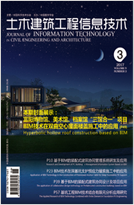2024, 16(6): 122-126. doi: 10.16670/j.cnki.cn11-5823/tu.2024.06.22
基于BIM技术的边坡地质建模与有限元分析
武汉工程大学 土木工程与建筑学院,武汉 430074 |
Slope Geological Modeling and Finite Element Analysis Based on BIM Technology
School of Civil Engineering and Architecture, Wuhan University of Engineering, China, Wuhan, Hubei 430074, China |
引用本文:
邓云月, 王章琼, 焦漫, 高翔. 基于BIM技术的边坡地质建模与有限元分析[J]. 土木建筑工程信息技术,
2024, 16(6): 122-126.
doi: 10.16670/j.cnki.cn11-5823/tu.2024.06.22

Citation:
Yunyue Deng, Zhangqiong Wang, Man Jiao, Xiang Gao. Slope Geological Modeling and Finite Element Analysis Based on BIM Technology[J]. Journal of Information Technologyin Civil Engineering and Architecture,
2024, 16(6): 122-126.
doi: 10.16670/j.cnki.cn11-5823/tu.2024.06.22

摘要:本文通过BIM技术与有限元分析软件的结合,建立边坡的三维地质模型并进行稳定性分析。使用Revit应用程序接口,结合Kriging插值法开发一款具有空间插值功能的插件,并运用插件对地质数据实现地质模型的精细化建模。模型通过几何转换接口导入到HyperMesh中,进行复杂几何体的处理再进行3D网格划分,通过quality index对划分好的网格进行质量评估,以inp格式文件导入Abaqus中进行边坡的稳定性分析计算,最后得到边坡失稳云图。地质模型导入有限元软件,实现了BIM技术与有限元技术的结合。这种技术流程提高了对地质情况的精确反映,插值计算后的模型曲面更真实地展现了地层的实际情况。一体化研究不仅使建筑、结构和岩土工程等多个领域的信息在一个统一模型中得以集成,而且有助于提高岩土工程分析精度和效率。
Abstract: Establishing a three-dimensional geological model of the slope and performing stability analysis through the integration of BIM technology and finite element analysis software. A plug-in with spatial interpolation function is developed using Revit application program interface combined with Kriging interpolation method, and the plug-in is applied to the geological data to realize the refinement modeling of the geological model. The model is imported into HyperMesh through the geometry conversion interface to process the complex geometry and then mesh the 3D mesh, and the mesh is evaluated by quality index, and then imported into Abaqus in inp format to analyze the stability of slopes and calculate the slope instability cloud map. The import of geological models into finite element software enables the integration of BIM technology with finite element techniques. This technological process enhances the accurate representation of geological conditions, with interpolated model surfaces more realistically reflecting actual ground conditions. The integration study not only enables the integration of information from multiple fields such as architectural, structural and geotechnical engineering in a unified model, but also helps improve the accuracy and efficiency of geotechnical analysis.
| [1] |
卞友艳. BIM技术在沪通铁路站场路基设计中的应用研究[J]. 铁道标准设计, 2020, 64(9): 6-9. |
| [2] |
钱佳鑫, 陈东, 邓树新. 建筑信息模型技术在城市密集区桥梁施工中的应用[J]. 科学技术与工程, 2022, 22(5): 2063-2068. |
| [3] |
刘惊灏, 苏谦, 陈俊杰, 等. 基于WebGL扩展模型的铁路运维可视化研究[J]. 铁道科学与工程学报, 2022, 19(4): 892-900. |
| [4] |
陈杰, 刘金辉, 曹莉苹, 等. 电火花震源在城市地质调查三维地震勘探中的应用[J]. 四川地质学报, 2021, 41(2): 295-298. |
| [5] |
Breunig M, Borrmann A, Rank E, et al. Collaborative multi-scale 3D city and infrastructure modeling and simulation[J]. The International Archives of the Photogrammetry, Remote Sensing and Spatial Information Sciences, 2017, 42: 341-352. |
| [6] |
Liu Y, Van Nederveen G A, Hertogh M, et al. Understanding effects of BlM on collaborativedesign and construction: An empirical study in China[J]. International Journal of Project Management, 2017, 35(4): 686-698.doi: 10.1016/j.ijproman.2016.06.007 |
| [7] |
何高峰, 罗先启, 张辉, 等. 基于BIM的地铁隧道结构分析与安全预警[J]. 地下空间与工程学报, 2019, 15(3): 920-926. |
| [8] |
陈国良, 吴佳明, 钟宇, 等. 基于IFC标准的三维地质模型扩展研究[J]. 岩土力学, 2020, 41(08): 2821-2828. |
| [9] |
徐卫亚, 孟永东, 田斌, 等. 复杂岩质高边坡三维地质建模及虚拟现实可视化[J]. 岩石力学与工程学报, 2010, 29(12): 2385-2397. |
| [10] |
王玄玄, 黄玉林, 赵金城, 等. Revit-Abaqus模型转换接口的开发与应用[J]. 上海交通大学学报, 2020, 54(2): 135-143. |
| [11] |
张晓洋, 胡振中. 面向结构有限元分析的模型转换方法研究[J]. 工程力学, 2017, 34(6): 120-127. |
| [12] |
张志清, 金雪峰, 肖书影, 等. 基于BIM的道路地质地面信息模型构建及应用[J]. 公路, 2021, 66(2): 28-34. |
| [13] |
张斌, 时伟, 徐铁城, 等. 基于Bentley市政工程三维地质模型创建应用研究[J]. 工程质量, 2018, 36(11): 71-74. |
| [14] |
Ugai K, Leshchinsky D. Three-dimensional limit equilibrium and finite element analyses: A comparison of results[J]. Journal of Japanese Geotechnical Society Soils & Foundation, 1995, 35(4): 1-7. |
| [15] |
李瀚林, 陈晓青. 基于极限平衡法和强度折减法的边坡稳定性研究[J]. 露天采矿技术, 2020, 35(06): 6-29. |
计量
- PDF下载量(3)
- 文章访问量(346)
- HTML全文浏览量(246)















